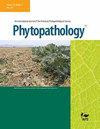Alexey Mikaberidze, C D Cruz, Ayalsew Zerihun, Abel Barreto, Pieter Beck, Rocío Calderón, Carlos Camino, Rebecca E Campbell, Stephanie K L Delalieux, Frédéric Fabre, Elin Falla, Stuart Fraser, Kaitlin M Gold, Carlos Gongora-Canul, Frédéric Hamelin, Dalphy O C Harteveld, Cheng-Fang Hong, Melen Leclerc, Da-Young Lee, Murillo Lobo, Anne-Katrin Mahlein, Emily McLay, Paul Melloy, Stephen Parnell, Uwe Rascher, Jack Rich, Irene Salotti, Samuel Soubeyrand, Susan Sprague, Antony Surano, Sandhya D Takooree, Thomas H Taylor, Suzanne Touzeau, Pablo J Zarco-Tejada, Nik J Cunniffe
求助PDF
{"title":"光学传感与流行病学建模相结合的机遇与挑战。","authors":"Alexey Mikaberidze, C D Cruz, Ayalsew Zerihun, Abel Barreto, Pieter Beck, Rocío Calderón, Carlos Camino, Rebecca E Campbell, Stephanie K L Delalieux, Frédéric Fabre, Elin Falla, Stuart Fraser, Kaitlin M Gold, Carlos Gongora-Canul, Frédéric Hamelin, Dalphy O C Harteveld, Cheng-Fang Hong, Melen Leclerc, Da-Young Lee, Murillo Lobo, Anne-Katrin Mahlein, Emily McLay, Paul Melloy, Stephen Parnell, Uwe Rascher, Jack Rich, Irene Salotti, Samuel Soubeyrand, Susan Sprague, Antony Surano, Sandhya D Takooree, Thomas H Taylor, Suzanne Touzeau, Pablo J Zarco-Tejada, Nik J Cunniffe","doi":"10.1094/PHYTO-11-24-0359-FI","DOIUrl":null,"url":null,"abstract":"<p><p>Plant diseases impair the yield and quality of crops and threaten the health of natural plant communities. Epidemiological models can predict disease and inform management. However, data are scarce, because traditional methods to measure plant diseases are resource intensive, which often limits model performance. Optical sensing offers a methodology to acquire detailed data on plant diseases across various spatial and temporal scales. Key technologies include multispectral, hyperspectral, and thermal imaging, as well as light detection and ranging; the associated sensors can be installed on ground-based platforms, uncrewed aerial vehicles, airplanes, and satellites. However, despite enormous potential for synergy, optical sensing and epidemiological modeling have rarely been integrated. To address this gap, we first review the state of the art to develop a common language accessible to both research communities. We then explore the opportunities and challenges in combining optical sensing with epidemiological modeling. We discuss how optical sensing can inform epidemiological modeling by improving model selection and parameterization and providing accurate maps of host plants. Epidemiological modeling can inform optical sensing by boosting measurement accuracy, improving data interpretation, and optimizing sensor deployment. We consider outstanding challenges in (A) identifying particular diseases; (B) data availability, quality, and resolution; (C) linking optical sensing and epidemiological modeling; and (D) emerging diseases. We conclude with recommendations to motivate and shape research and practice in both fields. Among other suggestions, we propose standardizing methods and protocols for optical sensing of plant health and developing open access databases including both optical sensing data and epidemiological models to foster cross-disciplinary work. [Formula: see text] Copyright © 2025 The Author(s). This is an open access article distributed under the CC BY-NC-ND 4.0 International license.</p>","PeriodicalId":20410,"journal":{"name":"Phytopathology","volume":" ","pages":"PHYTO11240359FI"},"PeriodicalIF":3.1000,"publicationDate":"2025-09-30","publicationTypes":"Journal Article","fieldsOfStudy":null,"isOpenAccess":false,"openAccessPdf":"","citationCount":"0","resultStr":"{\"title\":\"Opportunities and Challenges in Combining Optical Sensing and Epidemiological Modeling.\",\"authors\":\"Alexey Mikaberidze, C D Cruz, Ayalsew Zerihun, Abel Barreto, Pieter Beck, Rocío Calderón, Carlos Camino, Rebecca E Campbell, Stephanie K L Delalieux, Frédéric Fabre, Elin Falla, Stuart Fraser, Kaitlin M Gold, Carlos Gongora-Canul, Frédéric Hamelin, Dalphy O C Harteveld, Cheng-Fang Hong, Melen Leclerc, Da-Young Lee, Murillo Lobo, Anne-Katrin Mahlein, Emily McLay, Paul Melloy, Stephen Parnell, Uwe Rascher, Jack Rich, Irene Salotti, Samuel Soubeyrand, Susan Sprague, Antony Surano, Sandhya D Takooree, Thomas H Taylor, Suzanne Touzeau, Pablo J Zarco-Tejada, Nik J Cunniffe\",\"doi\":\"10.1094/PHYTO-11-24-0359-FI\",\"DOIUrl\":null,\"url\":null,\"abstract\":\"<p><p>Plant diseases impair the yield and quality of crops and threaten the health of natural plant communities. Epidemiological models can predict disease and inform management. However, data are scarce, because traditional methods to measure plant diseases are resource intensive, which often limits model performance. Optical sensing offers a methodology to acquire detailed data on plant diseases across various spatial and temporal scales. Key technologies include multispectral, hyperspectral, and thermal imaging, as well as light detection and ranging; the associated sensors can be installed on ground-based platforms, uncrewed aerial vehicles, airplanes, and satellites. However, despite enormous potential for synergy, optical sensing and epidemiological modeling have rarely been integrated. To address this gap, we first review the state of the art to develop a common language accessible to both research communities. We then explore the opportunities and challenges in combining optical sensing with epidemiological modeling. We discuss how optical sensing can inform epidemiological modeling by improving model selection and parameterization and providing accurate maps of host plants. Epidemiological modeling can inform optical sensing by boosting measurement accuracy, improving data interpretation, and optimizing sensor deployment. We consider outstanding challenges in (A) identifying particular diseases; (B) data availability, quality, and resolution; (C) linking optical sensing and epidemiological modeling; and (D) emerging diseases. We conclude with recommendations to motivate and shape research and practice in both fields. Among other suggestions, we propose standardizing methods and protocols for optical sensing of plant health and developing open access databases including both optical sensing data and epidemiological models to foster cross-disciplinary work. [Formula: see text] Copyright © 2025 The Author(s). This is an open access article distributed under the CC BY-NC-ND 4.0 International license.</p>\",\"PeriodicalId\":20410,\"journal\":{\"name\":\"Phytopathology\",\"volume\":\" \",\"pages\":\"PHYTO11240359FI\"},\"PeriodicalIF\":3.1000,\"publicationDate\":\"2025-09-30\",\"publicationTypes\":\"Journal Article\",\"fieldsOfStudy\":null,\"isOpenAccess\":false,\"openAccessPdf\":\"\",\"citationCount\":\"0\",\"resultStr\":null,\"platform\":\"Semanticscholar\",\"paperid\":null,\"PeriodicalName\":\"Phytopathology\",\"FirstCategoryId\":\"97\",\"ListUrlMain\":\"https://doi.org/10.1094/PHYTO-11-24-0359-FI\",\"RegionNum\":2,\"RegionCategory\":\"农林科学\",\"ArticlePicture\":[],\"TitleCN\":null,\"AbstractTextCN\":null,\"PMCID\":null,\"EPubDate\":\"\",\"PubModel\":\"\",\"JCR\":\"Q2\",\"JCRName\":\"PLANT SCIENCES\",\"Score\":null,\"Total\":0}","platform":"Semanticscholar","paperid":null,"PeriodicalName":"Phytopathology","FirstCategoryId":"97","ListUrlMain":"https://doi.org/10.1094/PHYTO-11-24-0359-FI","RegionNum":2,"RegionCategory":"农林科学","ArticlePicture":[],"TitleCN":null,"AbstractTextCN":null,"PMCID":null,"EPubDate":"","PubModel":"","JCR":"Q2","JCRName":"PLANT SCIENCES","Score":null,"Total":0}
引用次数: 0
引用
批量引用

 求助内容:
求助内容: 应助结果提醒方式:
应助结果提醒方式:


